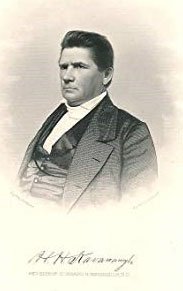
(Photograph from Kavanaugh United Methodist Church)
One of the earliest churches to still be at its original site is Kavanaugh United Methodist Church. The red brick structure with white columns has served congregations since that particular church opened in 1924. The church congregation was organized in 1896 as an offshoot of Wesley Methodist Church and held services there until 1921 when construction of the present-day church began. In 1896, an anonymous gentleman suggested naming the new church Kavanaugh in honor of Hubbard Hinde Kavanaugh (1802-1884), a highly esteemed Methodist Bishop from Kentucky.
Bishop Kavanaugh presided at the Annual Meeting of the North Texas Conference here in Greenville in 1881. For an hour and twenty minutes Kavanaugh “held the congregation spellbound, his imagination vivid, his voice clear, his strength unimpaired” another minister wrote. J. M. Binkley, another esteemed Methodist preacher called it the “most powerful and overwhelming sermon” he ever heard.
At an early age Kavanaugh began his ministerial career as a circuit preacher riding his horse over 200 miles to 25 appointments in 28 days. For five years he continued this rush on horseback from one point to another on the circuit. During this time, he became distinguished for his dauntless energy and untiring zeal in his work. He focused on preaching to both Black and White congregations. He served as Superintendent of Public Instruction in his native Kentucky in 1837, 1839, and 1840. He believed the concept was a good idea, but it was not accepted by locals.
By 1850 H. H. Kavanaugh had preached 3,330 sermons. In 1854 he was elevated to Bishop, a rank he held for almost fifty years.
Kavanaugh was a staunch supporter of temperance, Sunday Schools and the need for churches to provide parsonages for ministers and their families. He was active in supporting Camp Meetings, and retreats for ministers.
In 1845, political dissention in the United States disrupted the Methodist Church. Two separate branches formed. In those states that supported slavery and fought for the Confederacy sixteen years later, the branch became Methodist Episcopal Church South.
Bishop Kavanaugh was frequently called to communities to organize Methodist Churches. One such call was from San Francisco. In 1864 the Bishop was arrested as an enemy of the State of California and charged with interference in political matters in the war. The evidence was based on the name of his denomination since he was a member of the Methodist Episcopal Church South and a resident of Kentucky. (Kentucky never seceded from the Union.)
To show his allegiance to the United States, Kavanaugh offered to take the oath of allegiance to the United States of America and disclaimed any alliance to the Confederacy. After interviews with Captain John S. Mason, US Army, and Brig. General John S. Mason, Provost Marshal, Bishop Kavanaugh was vindicated of all charges.
He returned to his home in Kentucky and advised church leaders to remove the word “South” from the name of the denomination. He continued his work as a bishop, traveling throughout the South and the West. His visit to Greenville was one of his last. He died peacefully in March 1884.
